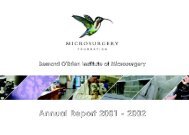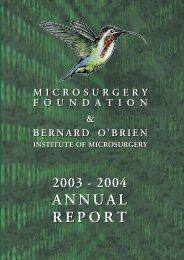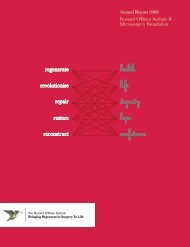annual report - O'Brien Institute
annual report - O'Brien Institute
annual report - O'Brien Institute
Create successful ePaper yourself
Turn your PDF publications into a flip-book with our unique Google optimized e-Paper software.
expression is increased following trauma, and in which<br />
cells it is expressed. We found that, as in animals, LIF is<br />
expressed within injured human nerves by a variety of<br />
cells, including Schwann cells and inflammatory cells, and<br />
that chronic neuromas continue to contain high levels of<br />
LIF for several years. These data suggest further<br />
examination is warranted to determine whether continued<br />
expression of LIF in unhealed injured nerves promotes or<br />
exacerbates the development of neuromas, or is simply a<br />
response to continued ‘trauma’.<br />
LIF and Schwann cell survival<br />
Schwann cells are cells which line the nerve fibres and<br />
play a major role in promoting nerve survival and<br />
regeneration after injury. They are the major source of<br />
LIF, and GDNF, at the injury site. Our own research has<br />
shown that Schwann cells require LIF for survival in<br />
culture, and that when we blocked LIF function within the<br />
entubulation repair site the survival of Schwann cells was<br />
markedly reduced. This suggests that one of the actions of<br />
LIF following nerve trauma is to prevent injury-induced<br />
cell death.<br />
Role of NOS 2 in nerve regeneration<br />
The nitric oxide producing protein NOS 2 is thought to<br />
play a role in blood vessel formation. It is also thought to<br />
be regulated in some tissues by LIF expression. We used<br />
the NOS 2 inhibitor AET administered for one month<br />
following nerve repair to determine whether NO-derived<br />
from NOS 2 played a role in nerve regeneration in our<br />
model, and whether the addition of LIF at the time of<br />
repair could overcome the effects of NOS 2 inhibition.<br />
When NOS 2 production is blocked with AET, in addition<br />
to repairing the nerve stumps, re-vascularisation and nerve<br />
regeneration are delayed within the silicone tube for up to<br />
4 weeks. Addition of LIF to the tube at the time of repair<br />
failed to overcome the effects of the AET. This series of<br />
experiments suggest that nitric oxide is important to<br />
angiogenesis and subsequent axon growth and may be<br />
required for the action of LIF.<br />
The treatment of pain resulting from a neuroma<br />
Neuromas are bulbous swellings which occur at the cut<br />
end of nerves, and these can become extremely painful,<br />
resulting in neuropathic pain and sometimes loss of work<br />
and, in extreme cases, suicidal tendencies. We are<br />
investigating the characteristics of the neuron population<br />
and local resident cells which contribute to the neuroma.<br />
Once a nerve is injured or cut and not repaired, a neuroma<br />
bulb forms at the cut end and persists for the life of the<br />
nerve. We have now shown that many uninjured nerve<br />
fibres grow into this end bulb neuroma, in addition to the<br />
injured nerves. We have commenced a very detailed study<br />
of motor nerves cells before injury, and after neuroma<br />
formation and will compare the effects of this procedure<br />
on the contralateral uninjured nerve cells.<br />
Alternative nerve repair methods<br />
In some circumstances it is not possible to repair an<br />
injured nerve branch by using the parent nerve and so an<br />
unrelated healthy nerve is used instead. Two methods of<br />
joining the injured nerve to the healthy nerve are possible.<br />
In the first, the healthy nerve is partially cut through and<br />
the ends of the injured nerve fibres are sutured to the cut<br />
ends of the healthy donor nerve fibres (end-end repair). In<br />
the other method, the injured nerve is sutured to the side of<br />
the uninjured nerve (end-side repair). We have shown that<br />
both these techniques result in a significant return of<br />
function to the denervated muscles. However, the end to<br />
end repair results in decreased function of the donor<br />
“muscles” whereas these muscles are spared by using end<br />
to side repair. Using a nerve tracer method, we determined<br />
that recovery of the denervated muscles is mediated by<br />
regeneration from nerve cells in the donor nerve and not<br />
from of the original nerve cells.<br />
When the distal stump of a severed nerve branch is<br />
rejoined to the parent nerve at a site distant to the point of<br />
severence, the denervated muscle regains some of its<br />
original function. We have shown that a number of nerve<br />
fibres grow down the parent nerve in newly formed tracks<br />
rather than joining the existing tracks of nerves. These<br />
nerve tracks originate at the level of the branch nerve<br />
injury and most likely include some of the original cut<br />
branch nerves fibres.<br />
Helen M Schutt Vascular Research<br />
Laboratory<br />
Senior Scientists: Geraldine Mitchell, Peter Vadiveloo.<br />
Clinical Research Fellow: Tony Penington.<br />
Members of the Laboratory:<br />
Angela Arvanitis, Mirna Boujaude, Rob Donato, Tanya<br />
Harkom, Peter Meagher, Wayne Morrison, Rosalind<br />
Romeo, Arthur Smardencas, and Debra Zafiropoulos.<br />
...and Major Collaborators:<br />
Brain Cooke d , Alastair Stewart a<br />
aDepartment of Pharmacology, University of Melbourne<br />
dDepartment of Microbiology, Monash University,<br />
Clayton, Vic.<br />
Blood vessel biology<br />
Successful outcomes for surgery depend upon a good<br />
blood supply to nourish repaired and transplanted tissue.<br />
In this laboratory we are trying to get a better idea of how<br />
blood vessels work, and how to manipulate blood vessels.<br />
The knowledge generated from this work will not only<br />
impact in areas of surgery but will also be relevant to<br />
diseases such as cancer, arthritis and atherosclerosis since<br />
changes in blood vessel growth and shape are important<br />
features of these diseases.<br />
Angiogenesis<br />
The process of new blood vessel formation is called<br />
angiogenesis. Until recently there has not been a clinically<br />
relevant experimental model. The scientists and surgeons<br />
at BOBIM have now developed such a model in rats and<br />
mice. This is an important step since we can now use the<br />
Director’s Report<br />
Bernard O’Brien <strong>Institute</strong> of Microsurgery<br />
Director<br />
Professor<br />
Wayne Morrison,<br />
MD, BS, FRACS<br />
Reconstruction following injury, tumour<br />
resection, burns or congenital deformity<br />
involves the transfer of tissues from one<br />
part of the body to another. Virtually every body<br />
part or tissue is capable of being transferred, e.g.<br />
skin, muscle, bone and joints, nerves, fat, or<br />
composite structures such as toes, scalp, etc. At<br />
the Bernard O’Brien <strong>Institute</strong> research was<br />
originally directed towards the role of<br />
microsurgery in this process of tissue transfer.<br />
Many of these techniques are now in common<br />
use throughout the world and for this reason our<br />
research is moving into the new frontier of tissue<br />
engineering. This is a natural progression in the<br />
sophistication of reconstructive techniques and of<br />
microsurgery where only miniscule amounts of<br />
the patient’s tissues are required to manufacture<br />
the derived product. Microsurgery plays an<br />
integral role in the process, firstly by supplying<br />
the core vascular pedicle on which the tissue is<br />
grown and then, if need be, in transferring the<br />
product to the desired site for reconstruction.<br />
Tissue engineering demands collaborations with<br />
experts in several fields, especially cell culture<br />
including stem cells, matrix biology, vascular<br />
biology and bioengineering. We are very<br />
fortunate to have in Melbourne many experts in<br />
these fields who are generously contributing their<br />
ideas. Tissue engineering offers the potential to<br />
repair defects without the need to sacrifice other<br />
areas of the body. It is an alternative to free tissue<br />
transfer, artificial prostheses and organ and tissue<br />
transplants.<br />
MICROSURGERY<br />
FOUNDATION<br />
The <strong>Institute</strong> also has a major interest in nerve<br />
repair following injury and in parallel with the<br />
pain management service under the direction of<br />
Dr Andrew Muir is interested in nerve pain,<br />
especially neuroma formation. Research<br />
includes the development of neuroma models<br />
and studies mapping the sources of nerve fibres<br />
which migrate into developing neuromas.<br />
Studies have shown in human neuromas that the<br />
growth factor (leukaemia inhibitory factor) is<br />
abundantly produced. The role of this growth<br />
factor in nerve repair and in pathological<br />
processes is being investigated. The Schwann<br />
cell which forms a sheath around nerve fibres is<br />
a major producer of this growth factor and other<br />
factors involved in the maintenance of nerve<br />
function and in repair processes following<br />
injury. Much of our research is directed towards<br />
understanding the behaviour of this cell.<br />
Injury to tissues following interference with<br />
blood supply (ischaemia) has particular<br />
relevance to our clinical work which involves<br />
reattachment of amputated parts and the<br />
transferring of tissues from one part of the body<br />
to another. Investigations understanding the<br />
nature of this injury and methods to minimise<br />
its effect have been a long time interest in our<br />
laboratory.<br />
Inflammation is a fundamental body response to<br />
injury and is integral to the repair process.<br />
Macrophage function is one of our special<br />
interests and research continues into the<br />
molecular mechanisms which activate<br />
macrophages.<br />
Scarring following injury is a major source of<br />
morbidity and compromises the results of<br />
operations, particularly in organs which require<br />
movement for function, such as the hand. We<br />
are investigating agents which prevent collagen<br />
formation and are hopeful that these will have a<br />
role in reducing the morbidity associated with<br />
injury and surgery.<br />
26 15






